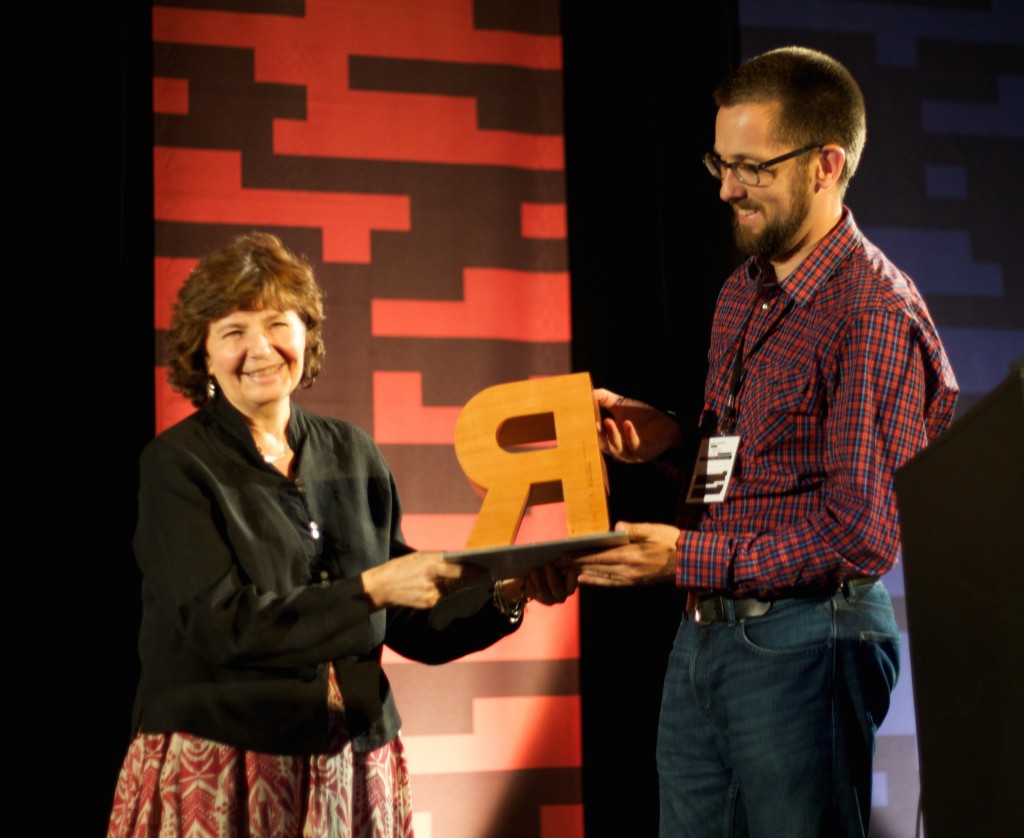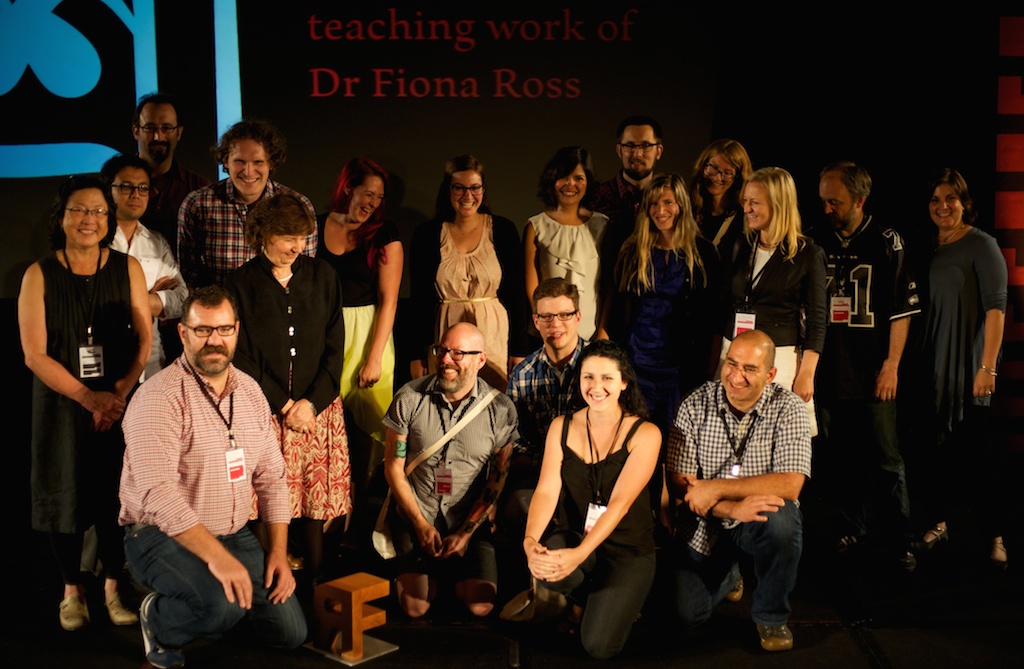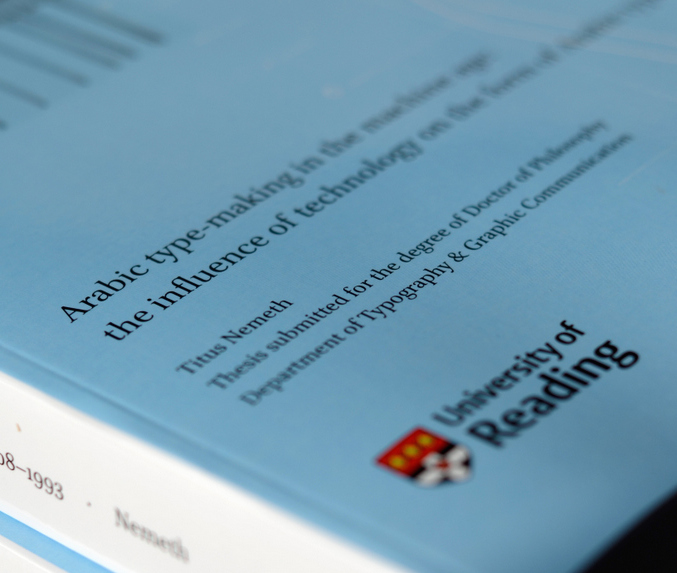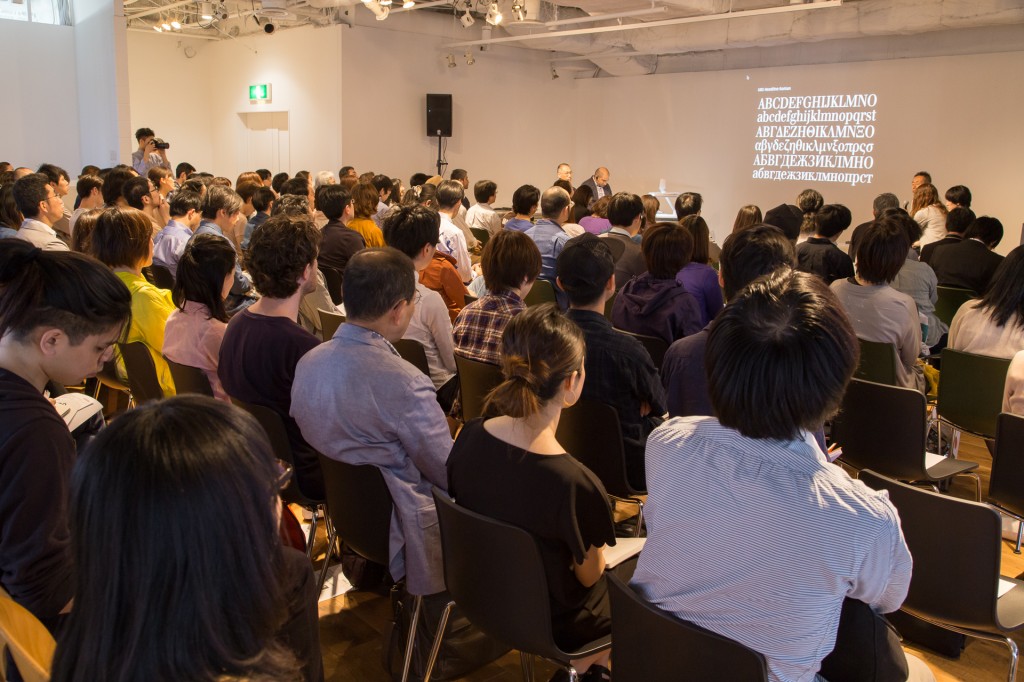Mariana Mota, Lead Interaction Designer at software and web apps company Oxford Computer Consultants, is writing a book on verbal communication and leadership for designers. Her first interview, on constructive feedback, was with Gerry Leonidas. An edited extract is on Talking Design.
Author Archives: gerryleonidas
A very special ATypI
As students were settling into their Halls for Welcome Week and the start of the new academic year, Sunday marked the return of several members of the Typography family from the annual ATypI conference, a highlight in the calendar of international type professionals. Held in Barcelona’s impressive new Museu del Diseny by MBM Arquitectes the conference was especially significant for Typography: to celebrate the award of the Sir Mischa Black Medal to Michael Twyman, the Association invited him to deliver the Keynote lecture on the topic of “Typography as a university study”. (The image above, of visuals marked up by Tschichold for a facsimile edition of Vespasiano’s 1572 writing manual, is from Michael’s collections – and seen by postgraduates who join his seminars.)
Forty years after the foundation of the Department of Typography & Graphic Communication (and a few more since the inception of the original course, in the late 1960s), Michael’s integration of history, theory and practice continues to define typographic education. These ideas have proven not only resilient, but prescient: graphic communication education worldwide is moving towards these ideas, holding Reading as a model for both new courses and institutions realigning their design studies.
(Above: Fiona Ross and Michael Twyman in Barcelona. Photos by Elena Veguillas)
Reading’s presence at the conference was notable. Eric Kindel and Gerard Unger delivered presentations, as did no less than ten MATD alumni, with two more taking part in panel sessions (Azza Alameddine, Nathalie Dumont, Paul Hunt, William Montrose, Toshi Omagari, Michele Patane, Dan Reynolds, Dan Rhatigan, Alice Savoie, Liron Lavi Turkenich; and Veronika Burian and Nadine Chahine respectively). Fiona Ross co-curated (with the regrettably absent Vaibhav Singh) the exhibition “Making news: type technologies in transition in newspapers across the world”. The selection of items from the Department’s Collections & Archives are a source of fascination and discussion by type designers, and reflect the growth of interest in global scripts.
ATypI president (and Reading alumnus) José Scaglione’s announcement that ATypI 2015 will take place in São Paulo, the first South American location for the Association, which will bring the conference closer to the substantial community of Brazilian alumni.
Web designers go for typefaces
Kicking off a busy week for Typography staff, Gerry Leonidas spoke to a full hall at Smashing Conference in Freiburg. The new talk focused on typefaces from a web designer’s perspective, and included key notions for evaluating typefaces. Web design professionals are increasingly interested in typography and typeface design, where the Department’s expertise has many contributions to make. By way of a reminder, Marko Dugonjić (amongst many other things, SmashingConf reporter on Twitter) noted:
After attending TDi in Reading with @gerryleonidas this summer, I’ve hugely upgraded my understanding of the Web. #justsaying #smashingconf
— Marko Dugonjić (@markodugonjic) September 16, 2014
Crossing Borders in Antwerp
The ninth Typosium, organised by Initiaal, took place at the Museum Plantin Moretus in Antwerp on 30 August, with the theme Crossing Borders/Genze(n)loos. Our own Jo De Baerdemaeker, Fiona Ross and Gerard Unger were amongst the presenters. Gerard spoke about his Alverata project, a contemporary typeface drawing on romanesque sources and employing a wide range of historically-inspired alternate shapes. Fiona wand Jo conducted a Dialogue on type, looking at a range of projects for global scripts. Pictures on Jan Van der Linden’s photostream.
Fiona Ross is awarded the SoTA Award
In a room bursting with applause and cheerful congratulations, Fiona Ross was awarded the prestigious SoTA Typography Award for her design and teaching work, during the TypeCon conference in Washington DC. The event began with prerecorded messages by graduates sending their congratulations from many countries holding up warm messages in some of the many scripts Fiona has supervised, followed by salutations by John Hudson and Gerry Leonidas.
Fiona’s first career in type design started when she took the job of coordinator for non-Latin typefaces at Linotype in 1978. John Hudson reminded the audience that “Over the following decade at Linotype, Fiona would build the non-Latin design department into the most technically and aesthetically creative team of its kind, employing designers, draughting staff and computer programmers selected by her. At a time when other companies were busy converting their old metal and photo types to the new digital technologies, Fiona undertook an extensive programme of innovative new typeface design for Indian, Arabic and Southeast Asian scripts, often working closely with the newspaper publishers and editors who were Linotype’s biggest customers.”
Hudson continued: “In addition to developing new designs for Indian scripts at this pivotal moment of technological change, Fiona also pioneered the use of phonetic keyboard input, using software to drive the visual display of characters, rather than requiring the typesetter to enter text in visual order. This model, in which phonetic character strings and visual glyph strings are separated—the now familiar separation of content and display—, influenced both ISCII, the Indian national standard for computing, and the Unicode Standard.”
Hudson outlined the many collaborations between Tiro Typeworks and Fiona as an independent consultant, starting with their collaboration, with Tim Holloway, on the redesign of the Yakout Arabic newspaper typeface: “…the first of many collaborations, each of which has been a wonderful adventure for me and a fascinating education. Together, we have made new types for Adobe, Microsoft and Linotype, in a range of scripts including Arabic, Bengali, Devanagari, Tamil, Telugu, and Thai. In the past two years we have been honoured to create custom types for the publishing of the Murty Classical Library of India by Harvard University Press.”
Fiona’s research focuses on the relationship of technology and typeface design, and has led to texts such as her book on the history of Bengali type, a key reference for the script. Her texts offer an exemplary model for the integration of research into typeface design, and are central to the building of a global reference library for non-Latin typeface design.
Through her teaching and supervision in the Department of Typography over the last 15 years, Fiona has helped establish the methodology for research-informed typeface design that is central to the MA Typeface Design programme, and a key element in a range of PhD projects. Important research projects on Arabic, Tibetan, and several Indian scripts, bear the mark of her approach. Far beyond the supervision within the Department, Fiona’s sharing and nurturing attitude to researchers and designers from around the world fosters an attitude of collaboration and learning that defines non-Latin typeface design today.
This is not about fonts
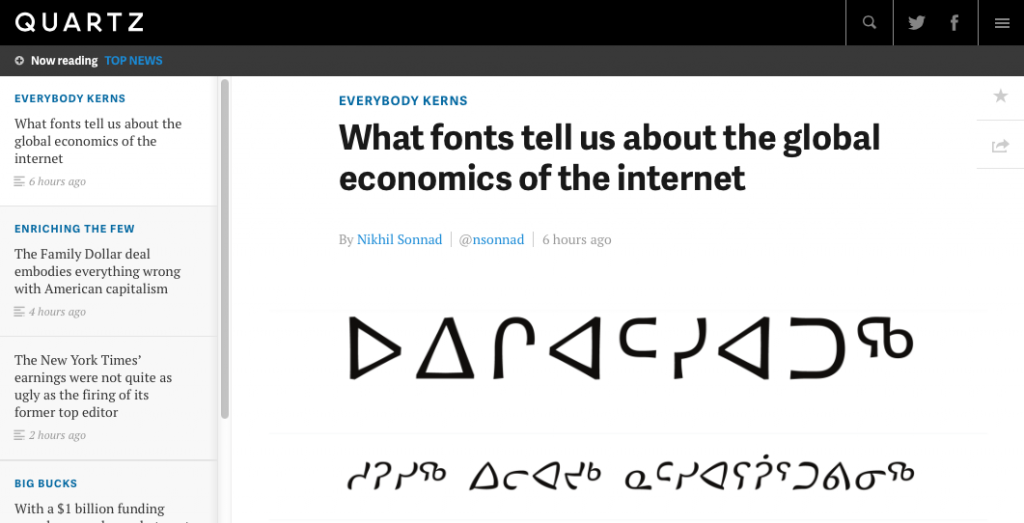 Quartz just published an extensive report on the globalisation of the typeface design market and the impact on the communication sector, with support from Gerry Leonidas, alumnus David Březina, and a reference to MATD alumna Juliet Shen’s design for Lushootsheed.
Quartz just published an extensive report on the globalisation of the typeface design market and the impact on the communication sector, with support from Gerry Leonidas, alumnus David Březina, and a reference to MATD alumna Juliet Shen’s design for Lushootsheed.
Quartz’s post is another entry in a the growing list of articles in business and general interest publications about typefaces, evidence that awareness about the importance of typeface design is spreading to fields far outside the design sector.
Doing a PhD at Reading
Titus Nemeth submitted his PhD thesis in 2013, on the evolution of Arabic type-making under the influence of changing technologies. The thesis spans the period from 1908, when the first adaptation of Arabic to mechanical typesetting introduced machine-aided composition; and 1993, when the adoption of Unicode marked the end of typeface design’s association with specific platforms. Titus’ research was supported by an AHRC Studentship.
Titus’ PhD represents a number of type-related research projects drawing on archival material, and is a useful reference for all researchers in this area. He has now published on his blog an engaging reflection on his experience doing a PhD at Reading. His article is a source of inspiration and guidance for potential researchers, and contains useful advice for research at this level.
The PhD was not Titus’ first experience in Reading. He had graduated from the MA Typeface Design in 2006, having completed an important Latin/Arabic typeface and a dissertation on Arabic newspaper typography.
Full house at TYPE& in Tokyo
Sponsored by Monotype, the 2014 TYPE& events in Tokyo included a masterclass for professional typeface designers, and presentations and panel discussion on multi-script typography and typeface design. The events captured the growing interest by Japanese type foundries to expand into Latin typeface design, and gave an opportunity to discuss Reading’s approach to developing multi-script design skills. Gerry Leonidas ran the masterclass on the first day of the event, and presented on the second, answering many questions on the MA Typeface Design programme’s contribution in the area. Reading alumna and Monotype employee Reiko Hirai was instrumental in the success of the event.
Gerry will be moving to a different part of Tokyo to spend a week at Mushashino Art University, and give a public lecture at the Toppan Printing Museum.
Журнал «Шрифт» features the MATD
The notable Russian online journal «Шрифт» (“Type”) published a substantial interview of Gerry Leonidas, programme director of the MA Typeface Design. The interview, which focuses on Reading’s pioneering approach to typographic education, is accompanied by images of student work and moments from the Department captured by Evgenia Basyrova.
The original text of the interview, in English, is available on this page.
Visit from Mushashino Art University

MAU visitors and Reading hosts, from left Ms Aki Amitani, Professor Yoshiro Goto, Gerry Leonidas, Toshi Omagari, Professor Gerard Unger, Yui Yoshitomi, Julian Moncada, Mari Kitamura, Akiko Maeda, Yukiko Aoshima.
Marking the University’s new connection with the Mushashino Art University of Tokyo, two staff members and four students visited the Department of Typography & Graphic Communication for an intensive week of typeface design. The group, led by Reading alumnus Professor Yoshiro Goto of the Visual Communication Design Department, used their time in Reading to conclude a collaborative project devised by Prof. Goto and Gerry Leonidas, and delve deeper into the Department’s research-informed approach to typographic practice. Their schedule combined dedicated sessions, as well as shared tutorials and seminars with current BA students. The group also took part in sessions of particular interest by Professors Michael Twyman and Gerard Unger. Assisting generously throughout the week were fellow alumni Julian Moncada and Toshi Omagari (also a MAU alumnus).
- Comparing representations of movement in battle plans
- Michael Twyman and Yoshiro Goto discussing the seminar on timelines.
- Feeding back on sketches for typefaces inspired by the Department’s temporary exhibition.
- Discovering early digital experiments in composition during a session shared with Part 3 students.








